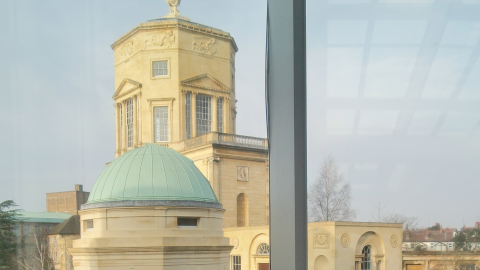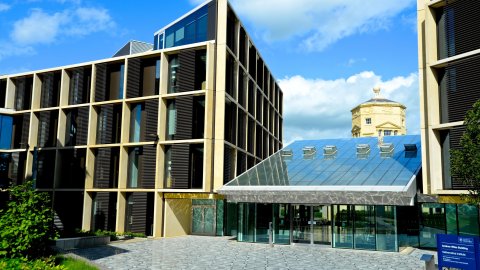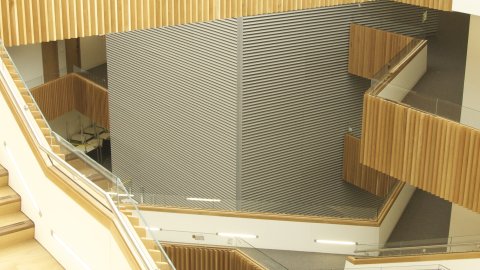Bayesian Mixture Models: Theory and Methods
Rousseau, J
Grazian, C
Lee, J
Handbook of Mixture Analysis
53-72
(04 Jan 2019)
Introduction to CTA Science
Acharya, B
Agudo, I
Al Samarai, I
Alfaro, R
Alfaro, J
Alispach, C
Batista, R
Amans, J
Amato, E
Ambrosi, G
Antolini, E
Antonelli, L
Aramo, C
Araya, M
Armstrong, T
Arqueros, F
Arrabito, L
Asano, K
Ashley, M
Backes, M
Balazs, C
Balbo, M
Ballester, O
Ballet, J
Bamba, A
Barkov, M
Barres de Almeida, U
Barrio, J
Bastieri, D
Becherini, Y
Belfiore, A
Benbow, W
Berge, D
Bernardini, E
Bernardini, M
Bernardos, M
Bernloehr, K
Bertucci, B
Biasuzzi, B
Bigongiari, C
Biland, A
Bissaldi, E
Biteau, J
Blanch, O
Blazek, J
Boisson, C
Bolmont, J
Bonanno, G
Bonardi, A
Bonavolonta, C
Bonnoli, G
Bosnjak, Z
Bottcher, M
Braiding, C
Bregeon, J
Brill, A
Brown, A
Brun, P
Brunetti, G
Buanes, T
Buckley, J
Bugaev, V
Buehler, R
Bulgarelli, A
Bulik, T
Burton, M
Burtovoi, A
Busetto, G
Canestrari, R
Capalbi, M
Capitanio, F
Caproni, A
Caraveo, P
Cardenas, V
Carlile, C
Carosi, R
Carquin, E
Carr, J
Casanova, S
Cascone, E
Catalani, F
Catalano, O
Cauz, D
Cerruti, M
Chadwick, P
Chaty, S
Chaves, R
Chen, A
Chen, X
Chernyakova, M
Chikawa, M
Christov, A
Chudoba, J
Cieslar, M
Coco, V
Colafrancesco, S
Colin, P
Conforti, V
Connaughton, V
Conrad, J
Contreras, J
Cortina, J
Costa, A
Costantini, H
Cotter, G
Covino, S
Crocker, R
Cuadra, J
Cuevas, O
Cumani, P
D'Ai, A
D'Ammando, F
D'Avanzo, P
D'Urso, D
Daniel, M
Davids, I
Dawson, B
Dazzi, F
De Angelis, A
de Cassia dos Anjos, R
De Cesare, G
De Franco, A
De Gouveia Dal Pino, E
de la Calle, I
Lopez, R
De Lotto, B
De Luca, A
De Lucia, M
de Naurois, M
de Ona Wilhelmi, E
De Palma, F
De Persio, F
de Souza, V
Deil, C
Del Santo, M
Delgado, C
della Volpe, D
Di Girolamo, T
Di Pierro, F
Di Venere, L
Diaz, C
Dib, C
Diebold, S
Djannati-Atai, A
Dominguez, A
Prester, D
Dorner, D
Doro, M
Drass, H
Dravins, D
Dubus, G
Dwarkadas, V
Ebr, J
Eckner, C
Egberts, K
Einecke, S
Ekoume, T
Elsaesser, D
Ernenwein, J
Espinoza, C
Evoli, C
Fairbairn, M
Falceta-Goncalves, D
Falcone, A
Farnier, C
Fasola, G
Fedorova, E
Fegan, S
Fernandez-Alonso, M
Fernandez-Barral, A
Ferrand, G
Fesquet, M
Filipovic, M
Fioretti, V
Fontaine, G
Fornasa, M
Fortson, L
Freixas Coromina, L
Fruck, C
Fujita, Y
Fukazawa, Y
Funk, S
Fuessling, M
Gabici, S
Gadola, A
Gallant, Y
Garcia, B
Garcia Lopez, R
Garczarczyk, M
Gaskins, J
Gasparetto, T
Gaug, M
Gerard, L
Giavitto, G
Giglietto, N
Giommi, P
Giordano, F
Giro, E
Giroletti, M
Giuliani, A
Glicenstein, J
Gnatyk, R
Godinovic, N
Goldoni, P
Gomez-Vargas, G
Gonzalez, M
Gonzalez, J
Gotz, D
Graham, J
Grandi, P
Granot, J
Green, A
Greenshaw, T
Griffiths, S
Gunji, S
Hadasch, D
Hara, S
Hardcastle, M
Hassan, T
Hayashi, K
Hayashida, M
Heller, M
Helo, J
Hermann, G
Hinton, J
Hnatyk, B
Hofmann, W
Holder, J
Horan, D
Horandel, J
Horns, D
Horvath, P
Hovatta, T
Hrabovsky, M
Hrupec, D
Humensky, T
Huetten, M
Iarlori, M
Inada, T
Inome, Y
Inoue, S
Inoue, T
Inoue, Y
Iocco, F
Ioka, K
Iori, M
Ishio, K
Iwamura, Y
Jamrozy, M
Janecek, P
Jankowsky, D
Jean, P
Jung-Richardt, I
Jurysek, J
Kaaret, P
Karkar, S
Katagiri, H
Katz, U
Kawanaka, N
Kazanas, D
Khelifi, B
Kieda, D
Kimeswenger, S
Kimura, S
Kisaka, S
Knapp, J
Knodlseder, J
Koch, B
Kohri, K
Komin, N
Kosack, K
Kraus, M
Krause, M
Krauss, F
Kubo, H
Mezek, G
Kuroda, H
Kushida, J
La Palombara, N
Lamanna, G
Lang, R
Lapington, J
Le Blanc, O
Leach, S
Lees, J
Lefaucheur, J
Leigui de Oliveira, M
Lenain, J
Lico, R
Limon, M
Lindfors, E
Lohse, T
Lombardi, S
Longo, F
Lopez, M
Lopez-Coto, R
Lu, C
Lucarelli, F
Luque-Escamilla, P
Lyard, E
Maccarone, M
Maier, G
Majumdar, P
Malaguti, G
Mandat, D
Maneva, G
Manganaro, M
Mangano, S
Marcowith, A
Marin, J
Markoff, S
Marti, J
Martin, P
Martinez, M
Martinez, G
Masetti, N
Masuda, S
Maurin, G
Maxted, N
Mazin, D
Medina, C
Melandri, A
Mereghetti, S
Meyer, M
Minaya, I
Mirabal, N
Mirzoyan, R
Mitchell, A
Mizuno, T
Moderski, R
Mohammed, M
Mohrmann, L
Montaruli, T
Moralejo, A
Morcuende-Parrilla, D
Mori, K
Morlino, G
Morris, P
Morselli, A
Moulin, E
Mukherjee, R
Mundell, C
Murach, T
Muraishi, H
Murase, K
Nagai, A
Nagataki, S
Nagayoshi, T
Naito, T
Nakamori, T
Nakamura, Y
Niemiec, J
Nieto, D
Nikolajuk, M
Nishijima, K
Noda, K
Nosek, D
Novosyadlyj, B
Nozaki, S
O'Brien, P
Oakes, L
Ohira, Y
Ohishi, M
Ohm, S
Okazaki, N
Okumura, A
Ong, R
Orienti, M
Orito, R
Osborne, J
Ostrowski, M
Otte, N
Oya, I
Padovani, M
Paizis, A
Palatiello, M
Palatka, M
Paoletti, R
Paredes, J
Pareschi, G
Parsons, R
Pe'er, A
Pech, M
Pedaletti, G
Perri, M
Persic, M
Petrashyk, A
Petrucci, P
Petruk, O
Peyaud, B
Pfeifer, M
Piano, G
Pisarski, A
Pita, S
Pohl, M
Polo, M
Pozo, D
Prandini, E
Prast, J
Principe, G
Prokhorov, D
Prokoph, H
Prouza, M
Puehlhofer, G
Punch, M
Puerckhauer, S
Queiroz, F
Quirrenbach, A
Raino, S
Razzaque, S
Reimer, O
Reimer, A
Reisenegger, A
Renaud, M
Rezaeian, A
Rhode, W
Ribeiro, D
Ribo, M
Richtler, T
Rico, J
Rieger, F
Riquelme, M
Rivoire, S
Rizi, V
Rodriguez, J
Fernandez, G
Rodriguez Vazquez, J
Rojas, G
Romano, P
Romeo, G
Rosado, J
Rovero, A
Rowell, G
Rudak, B
Rugliancich, A
Rulten, C
Sadeh, I
Safi-Harb, S
Saito, T
Sakaki, N
Sakurai, S
Salina, G
Sanchez-Conde, M
Sandaker, H
Sandoval, A
Sangiorgi, P
Sanguillon, M
Sano, H
Santander, M
Sarkar, S
Satalecka, K
Saturni, F
Schioppa, E
Schlenstedt, S
Schneider, M
Schoorlemmer, H
Schovanek, P
Schulz, A
Schussler, F
Schwanke, U
Sciacca, E
Scuderi, S
Seitenzahl, I
Semikoz, D
Sergijenko, O
Servillat, M
Shalchi, A
Shellard, R
Sidoli, L
Siejkowski, H
Sillanpaa, A
Sironi, G
Sitarek, J
Sliusar, V
Slowikowska, A
Sol, H
Stamerra, A
Stanic, S
Starling, R
Stawarz, L
Stefanik, S
Stephan, M
Stolarczyk, T
Stratta, G
Straumann, U
Suomijarvi, T
Supanitsky, A
Tagliaferri, G
Tajima, H
Tavani, M
Tavecchio, F
Tavernet, J
Tayabaly, K
Tejedor, L
Temnikov, P
Terada, Y
Terrier, R
Terzic, T
Teshima, M
Testa, V
Thoudam, S
Tian, W
Tibaldo, L
Tluczykont, M
Todero Peixoto, C
Tokanai, F
Tomastik, J
Tonev, D
Tornikoski, M
Torres, D
Torresi, E
Tosti, G
Tothill, N
Tovmassian, G
Travnicek, P
Trichard, C
Trifoglio, M
Pujadas, I
Tsujimoto, S
Umana, G
Vagelli, V
Vagnetti, F
Valentino, M
Vallania, P
Valore, L
van Eldik, C
Vandenbroucke, J
Varner, G
Vasileiadis, G
Vassiliev, V
Vazquez Acosta, M
Vecchi, M
Vega, A
Vercellone, S
Veres, P
Vergani, S
Verzi, V
Vettolani, G
Viana, A
Vigorito, C
Villanueva, J
Voelk, H
Vollhardt, A
Vorobiov, S
Vrastil, M
Vuillaume, T
Wagner, S
Wagner, R
Walter, R
Ward, J
Warren, D
Watson, J
Werner, F
White, M
White, R
Wierzcholska, A
Wilcox, P
Will, M
Williams, D
Wischnewski, R
Wood, M
Yamamoto, T
Yamazaki, R
Yanagita, S
Yang, L
Yoshida, T
Yoshiike, S
Yoshikoshi, T
Zacharias, M
Zaharijas, G
Zampieri, L
Zandanel, F
Zanin, R
Zavrtanik, M
Zavrtanik, D
Zdziarski, A
Zech, A
Zechlin, H
Zhdanov, V
Ziegler, A
Zorn, J
SCIENCE WITH THE CHERENKOV TELESCOPE ARRAY
1-+
(2019)
https://www.webofscience.com/api/gateway?GWVersion=2&SrcApp=elements_prod_1&SrcAuth=WosAPI&KeyUT=WOS:000467612100001&DestLinkType=FullRecord&DestApp=WOS_CPL
Ten Digit Problems
Trefethen, L
An Invitation to Mathematics
119-136
(2011)
Approximation Theory and Approximation Practice, Extended Edition
Trefethen, L
(25 Jan 2019)
Distributions and Function Spaces
Jovanovic, B
Sueli, E
ANALYSIS OF FINITE DIFFERENCE SCHEMES: FOR LINEAR PARTIAL DIFFERENTIAL EQUATIONS WITH GENERALIZED SOLUTIONS
volume 46
1-90
(2014)
https://www.webofscience.com/api/gateway?GWVersion=2&SrcApp=elements_prod_1&SrcAuth=WosAPI&KeyUT=WOS:000332097700002&DestLinkType=FullRecord&DestApp=WOS_CPL
Elliptic Boundary-Value Problems
Jovanovic, B
Sueli, E
ANALYSIS OF FINITE DIFFERENCE SCHEMES: FOR LINEAR PARTIAL DIFFERENTIAL EQUATIONS WITH GENERALIZED SOLUTIONS
volume 46
91-243
(2014)
https://www.webofscience.com/api/gateway?GWVersion=2&SrcApp=elements_prod_1&SrcAuth=WosAPI&KeyUT=WOS:000332097700003&DestLinkType=FullRecord&DestApp=WOS_CPL
Analysis of Finite Difference Schemes For Linear Partial Differential Equations with Generalized Solutions Preface
Jovanovic, B
Sueli, E
ANALYSIS OF FINITE DIFFERENCE SCHEMES: FOR LINEAR PARTIAL DIFFERENTIAL EQUATIONS WITH GENERALIZED SOLUTIONS
volume 46
V-+
(2014)
https://www.webofscience.com/api/gateway?GWVersion=2&SrcApp=elements_prod_1&SrcAuth=WosAPI&KeyUT=WOS:000332097700001&DestLinkType=FullRecord&DestApp=WOS_CPL
Finite Difference Approximation of Hyperbolic Problems
Jovanovic, B
Sueli, E
ANALYSIS OF FINITE DIFFERENCE SCHEMES: FOR LINEAR PARTIAL DIFFERENTIAL EQUATIONS WITH GENERALIZED SOLUTIONS
volume 46
327-387
(2014)
https://www.webofscience.com/api/gateway?GWVersion=2&SrcApp=elements_prod_1&SrcAuth=WosAPI&KeyUT=WOS:000332097700005&DestLinkType=FullRecord&DestApp=WOS_CPL
Finite Difference Approximation of Parabolic Problems
Jovanovic, B
Sueli, E
ANALYSIS OF FINITE DIFFERENCE SCHEMES: FOR LINEAR PARTIAL DIFFERENTIAL EQUATIONS WITH GENERALIZED SOLUTIONS
volume 46
245-325
(2014)
https://www.webofscience.com/api/gateway?GWVersion=2&SrcApp=elements_prod_1&SrcAuth=WosAPI&KeyUT=WOS:000332097700004&DestLinkType=FullRecord&DestApp=WOS_CPL





